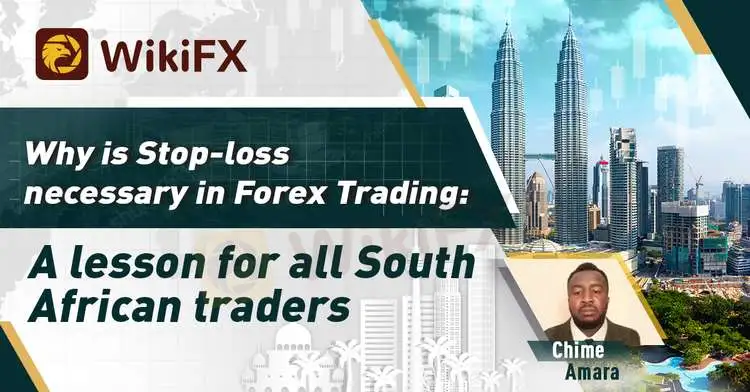简体中文
繁體中文
English
Pусский
日本語
ภาษาไทย
Tiếng Việt
Bahasa Indonesia
Español
हिन्दी
Filippiiniläinen
Français
Deutsch
Português
Türkçe
한국어
العربية
Why is Stop-loss necessary in Forex Trading: A lesson for all South African traders
Abstract:The Forex Market is a very volatile market. The market volatility in some cases could be so much that losses could exceed one's capital. According to the research carried out by most forex brokers; virtually 65% of Forex traders lose their capital while trading due to market volatility. To guard against this, traders have been provided with the option of using Stop-loss while placing their orders in the market. Stop-loss is the trader's friend as it helps to avoid excessive loss leading to the total loss of one's capital due to market volatility. It is therefore expected that all forex traders must imbibe the practice of using Stop-loss while placing their orders at the market.

By: Chime Amara

The Forex Market is a very volatile market. The market volatility in some cases could be so large that losses could exceed one's capital. According to the research carried out by most forex brokers, virtually 65% of Forex traders lose their capital while trading due to market volatility. To guard against this, traders have been provided with the option of using Stop-loss while placing their orders in the market. Stop-loss is the trader's friend as it helps to avoid excessive loss leading to the total loss of one's capital due to market volatility. It is therefore expected that all forex traders must imbibe the practice of using Stop-loss while placing their orders at the market.
What is Stop-loss?
Stop-loss is a pending market order set in the opposite direction of the trader's position and designed to close the trader's open position in cases where the market goes so badly against him. Very often, experts consider the ideal Stop-loss target to be 30 - 50 pips away from the trader's entry position. Setting Stop-loss is the best risk management practice to prevent excessive loss in cases of prolonged one-directional market volatility contrary to the trader's position. It reduces the chances of losing one's capital entirely whenever the market goes wrong.
Advantages of Using Stop-loss
· Helps to avoid excessive loss
· Prevents blowing up of account
· Reduces the trader's anxiety
Disadvantages of using Stop-loss
· The market could easily hit ones Stop-loss and reverse
· Decreases one capital
· Often there could be a deliberate Stop-loss hunt by liquidity providers

Disclaimer:
The views in this article only represent the author's personal views, and do not constitute investment advice on this platform. This platform does not guarantee the accuracy, completeness and timeliness of the information in the article, and will not be liable for any loss caused by the use of or reliance on the information in the article.
Read more

Why You Shouldn't Be Afraid to Trust Your Capital to Regulated Brokers
Discover why regulated brokers offer safety for your capital with oversight, security, and transparency, plus the risks of unregulated options. Invest with confidence.

Prop Trading Firms vs. CFD Brokers: Who’s Winning the Retail Trading Race?
In recent years, a new breed of retailer-focused trading firms has emerged: proprietary (prop) trading outfits that recruit individual traders to trade the firm’s capital under structured rules. Boasting low entry costs, clear risk parameters, and profit-sharing incentives, these prop firms are rapidly winning over retail traders, many of whom previously traded Contracts for Difference (CFDs) with established online brokers. As prop trading revenues accelerate, a key question arises: Are CFD brokers losing business to prop firms?

Another ‘Tan Sri’ Targeted, RM347 Million in Assets Seized in MBI Scam
Malaysia’s police are stepping up their investigation into the MBI investment scam, a multi-billion ringgit fraud that has dragged on for nearly a decade. The Royal Malaysian Police (PDRM) is now planning to arrest another prominent figure with the title ‘Tan Sri’, following recent arrests and major asset seizures.

Why People Fall for Online Trading Scams
Learn why people fall for online trading scams, common tactics used by scammers, psychological triggers, red flags, and how to protect yourself from fraud.
WikiFX Broker
Latest News
Why Risk Management Alone Won’t Save Your Trading Account
Are We in a New Gold Rush? Everyone’s Talking About Gold Again!
How Easy Money Turned Into a Costly Mistake of RM130,000
StoneX Subsidiary, Gain Global Markets Bermuda, Penalized for Trading Misconduct
Bursa Trading Accounts Hacked | Check if Your Trades Are Hijacked!
The Crypto Shift: Challenges and Opportunities for Traditional Brokers
Currency Calculator


